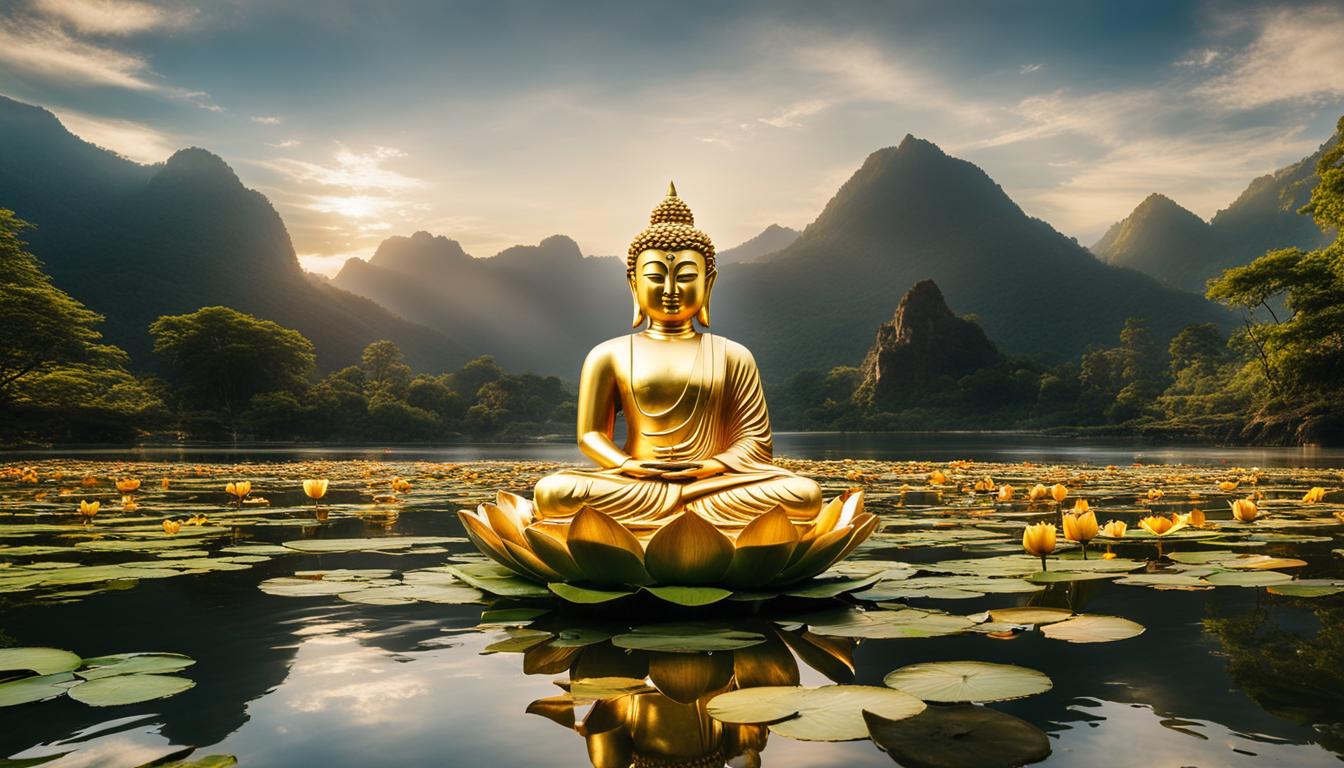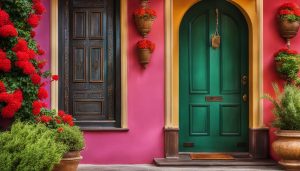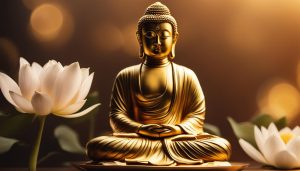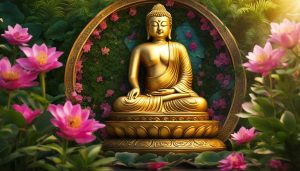Welcome to our guide on the auspicious direction in which Buddha should face for good luck! According to Vastu experts, the placement of Buddha statues in your home can have a profound impact on your mental well-being and attract positive energy. By strategically positioning these sacred statues, you can create a harmonious and serene environment that invites blessings and prosperity.
Contents
- 1 The Significance of Buddha Statue Placement in Feng Shui
- 2 Placing Buddha Statues for Positive Energy in Your Home
- 3 How Buddha Statues Enhance the Energy of Your Home
- 4 Conclusion: Harnessing the Positive Energy of Buddha Statues in Your Home
- 5 FAQ
- 5.1 What is the significance of placing Buddha statues in different areas of the home?
- 5.2 Where should I place a Buddha statue for good luck?
- 5.3 What direction should a reclining Buddha face?
- 5.4 Where is the best place to put a meditating Buddha statue?
- 5.5 What does a Bhumisparsha Buddha statue represent?
- 5.6 Where can I place a praying Buddha statue?
- 5.7 Can Buddha statues be placed in the garden?
- 5.8 Are there any restrictions on where to place Buddha busts?
- 5.9 Where should I place a laughing Buddha statue?
- 5.10 Can Buddha paintings and decals be used for a serene atmosphere?
- 6 Source Links
Key Takeaways:
- Placing a Buddha statue facing the entrance door can help keep negative forces at bay and invite positive energy into your home.
- If you want to cultivate peace and harmony, consider positioning a reclining Buddha facing west in your living room.
- A meditating Buddha placed in a clean corner of your garden can create a serene and tranquil atmosphere.
- In a pooja or meditation room, a meditating Buddha facing east represents eternal knowledge and enlightenment.
- For academic success, consider placing a small head of Buddha or reclining Buddha facing east in the kids’ room or study.
The Significance of Buddha Statue Placement in Feng Shui
In Feng Shui, the placement of a Buddha statue holds great significance as it is believed to harness positive chi or energy. The direction in which the Buddha statue faces plays a crucial role in attracting good luck and prosperity. By strategically placing Buddha statues in your home, you can create a harmonious environment and invite positive energy.
A Buddha statue facing the entrance door is said to attract positive energy and repel negative forces. This placement symbolizes the welcoming of blessings into your home. Additionally, a reclining Buddha statue facing west promotes inner harmony and serenity, making it a perfect addition to your living room.
For quiet corners such as a pooja room or meditation space, a meditating Buddha statue is ideal. Placing a meditating Buddha in these areas creates a calm and serene environment, allowing you to find inner peace and relaxation. Bhumisparsha Buddha statues, when placed facing east, represent enlightenment and eternal knowledge, making them ideal for a dedicated spiritual space.
“Placing a Buddha statue facing the entrance door can attract positive energy and repel negative forces.”
Praying Buddha statues symbolize devotion and can be placed in a pooja room or altar, serving as a reminder of your spiritual practice. It is recommended to position them above eye level to elevate the significance of their presence. In outdoor spaces such as gardens, placing Buddha statues near water bodies or amidst flowering plants symbolizes spiritual growth and rejuvenation.
Lastly, laughing Buddha statues facing east are believed to bring luck and prosperity. Their presence can create a joyful ambiance in your home. Buddha paintings and decals can also be used to enhance the serenity of your living room or near the main entrance, adding a touch of tranquility to your space.
| Buddha Statue Placement | Benefits |
|---|---|
| Facing the entrance | Attracts positive energy and repels negative forces |
| Reclining Buddha facing west | Promotes inner harmony and serenity |
| Meditating Buddha in pooja or meditation room | Creates a calm and serene environment |
| Bhumisparsha Buddha facing east | Represents enlightenment and eternal knowledge |
| Praying Buddha in pooja room or altar | Symbolizes devotion and spiritual practice |
| Buddha statues in the garden | Symbolize spiritual growth and rejuvenation |
| Laughing Buddha facing east | Brings luck and prosperity, creates a joyful ambiance |
Placing Buddha Statues for Positive Energy in Your Home
When it comes to inviting positive energy and luck into your home, the placement of Buddha statues plays a crucial role. The direction in which a Buddha statue faces can determine its impact on the energy flow within your living space. To enhance the positive energy in different areas of your home, consider the following placement guidelines:
The Entrance Door:
To repel negative energy and invite blessings into your home, place a Buddha statue facing the entrance door. This position symbolizes protection and acts as a guardian against unwanted forces.
The Living Room:
For a peaceful and harmonious atmosphere, position a Buddha statue in your living room facing the west. This direction promotes a sense of serenity and balance, creating a calming effect on both residents and visitors.
The Pooja or Meditation Room:
Create an environment of inner peace and relaxation by placing a meditating Buddha statue in a quiet corner of your home, such as a pooja or meditation room. For maximum impact, position the statue to face east, representing eternal knowledge and enlightenment.
The Garden:
Add a touch of spirituality and rejuvenation to your garden by placing a Buddha statue near water bodies or flowering plants. This placement symbolizes spiritual growth and connects with the natural elements surrounding your home.
In addition to these specific placements, you can also consider other areas for Buddha statues, such as the kids’ room, study, dining area, or bookshelf, depending on the desired energy and purpose. By strategically positioning Buddha statues throughout your home, you can create a harmonious and positive environment that supports your well-being.
| Location | Direction | Significance |
|---|---|---|
| The Entrance Door | Facing the entrance | Repels negative energy, invites blessings |
| The Living Room | Facing west | Brings peace and harmony |
| The Pooja or Meditation Room | Facing east | Promotes inner peace and enlightenment |
| The Garden | Near water bodies or flowering plants | Symbolizes spiritual growth and rejuvenation |
How Buddha Statues Enhance the Energy of Your Home
Placing Buddha statues in your home can have a profound impact on the energy and atmosphere within your living space. These statues are not only beautiful pieces of art but also carry deep spiritual significance. By strategically placing Buddha statues throughout your home, you can create a serene and harmonious environment that attracts positive energy and brings a sense of tranquility.
A key aspect to consider when placing Buddha statues is their facing direction. Each direction holds a specific meaning and can influence the energy flow in different areas of your home. For example, placing a Buddha statue facing the entrance door can act as a guardian, repelling negative energy and inviting blessings into your home.
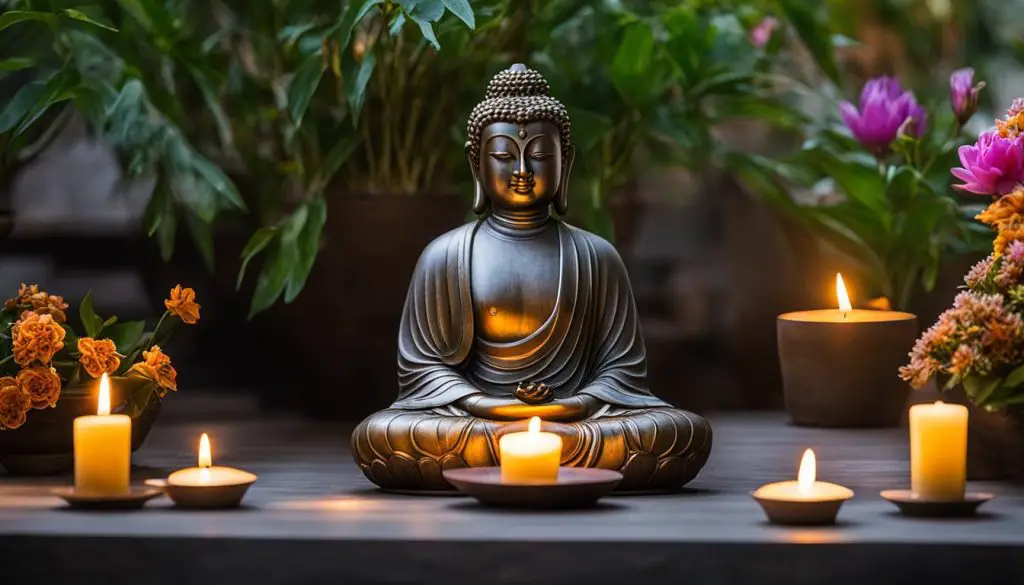
Buddha statues also have different symbolic poses that can further enhance their energy. For instance, a reclining Buddha facing west represents inner harmony and encourages a sense of peace within your home. Meditating Buddha statues create a calm and serene environment, making them perfect for placement in a pooja room or meditation space.
To further amplify the positive energy of your home, you can place Buddha statues in different areas, such as the garden or near water bodies, to symbolize spiritual growth and rejuvenation. Additionally, laughing Buddha statues placed facing east are believed to bring luck and prosperity into your life.
Incorporating Buddha paintings and decals can also add to the overall tranquility of your home. These can be placed in the living room or near the main entrance, creating a welcoming and serene atmosphere for both residents and guests.
Table: Symbolic Meanings of Buddha Statue Placements
| Placement | Direction | Symbolic Meaning |
|---|---|---|
| Entrance Door | Facing the door | Guardian, repels negative energy |
| Living Room | West | Inner harmony, peace |
| Pooja Room/Meditation Space | East | Enlightenment, eternal knowledge |
| Garden | Near water bodies or flowering plants | Spiritual growth, rejuvenation |
| Anywhere in the Home | – | Artistic expression, positive energy |
| Laughing Buddha | East | Luck, prosperity |
In conclusion, Buddha statues have the power to enhance the energy of your home and bring a sense of peace and positivity. By carefully considering their placement and the symbolic meaning behind each pose and direction, you can create a harmonious living space that fosters tranquility and attracts good fortune into your life.
Conclusion: Harnessing the Positive Energy of Buddha Statues in Your Home
Placing Buddha statues in your home can create a peaceful and harmonious environment. The direction in which a Buddha statue faces is significant for attracting good luck and positive energy. The right placement of Buddha statues can bring a sense of tranquility and positive vibes to your living space.
For example, placing a Buddha statue near the entrance door can symbolize blessings and protect your home from negative energy. A reclining Buddha facing west can bring a sense of peace and inner harmony. Meditating Buddha statues, when placed in a pooja or meditation room facing east, can promote a calm and serene atmosphere and aid in your spiritual practice.
Bhumisparsha Buddha statues facing east represent enlightenment and eternal knowledge, while praying Buddha statues inspire devotion and are perfect for a pooja room or altar. If you have a garden, consider placing a Buddha statue near water bodies or flowering plants to encourage spiritual growth and rejuvenation.
Buddha busts can serve as art pieces and can be placed in various areas of your home, except for places with challenging energy. Laughing Buddha statues facing east are believed to bring luck and prosperity. Additionally, Buddha paintings and decals can add a sense of serenity to your living room or near the main entrance.
By strategically placing Buddha statues in your home, you can harness the positive energy and luck they bring. Select statues that resonate with you and create a space that promotes calmness, positivity, and spiritual well-being.
FAQ
What is the significance of placing Buddha statues in different areas of the home?
Placing Buddha statues in different areas of the home can impact your mental health and bring positive energy.
Where should I place a Buddha statue for good luck?
According to Vastu experts, placing a Buddha statue facing the entrance door can attract positive energy and repel negative forces.
What direction should a reclining Buddha face?
A reclining Buddha facing west can encourage inner harmony and serenity.
Where is the best place to put a meditating Buddha statue?
Meditating Buddha statues are best suited for quiet corners, such as a pooja room or meditation space.
What does a Bhumisparsha Buddha statue represent?
Bhumisparsha Buddha statues, facing east, represent enlightenment and eternal knowledge.
Where can I place a praying Buddha statue?
Praying Buddha statues symbolize devotion and are ideal for placement in a pooja room or altar.
Can Buddha statues be placed in the garden?
Yes, Buddha statues in the garden, near water bodies or flowering plants, symbolize spiritual growth and rejuvenation.
Are there any restrictions on where to place Buddha busts?
Buddha busts can be placed anywhere, except in challenging energy areas like bathrooms or storerooms.
Where should I place a laughing Buddha statue?
Laughing Buddha statues facing east are believed to bring luck and prosperity.
Can Buddha paintings and decals be used for a serene atmosphere?
Yes, Buddha paintings and decals can create a serene atmosphere in the living room or near the main entrance.
Source Links
- https://www.livspace.com/in/magazine/where-to-keep-buddha-statue-in-the-house
- https://templesandmarkets.com.au/blogs/southeastasiastories/7-good-places-to-place-buddhas-in-your-home
- https://timesofindia.com/life-style/home-garden/7-vastu-recommended-places-to-keep-a-buddha-statue-at-home/photostory/83628149.cms

